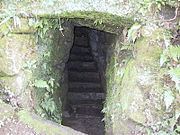 | ||
tonkararin tunnel structure
The Tonkararin (トンカラリン, Tonkararin) or Tonkararin tunnel structure is a 464.6 meter long, tunnel-like structure of unknown origin, situated in the Nagomi machi, Kumamoto Prefecture. It lies on a plateau called Seibaru Daichi, around which are many kofuns or tumuli, such as Eda-Funayama Kofun. It consists of very shallow natural slits of the ground covered with stones and man-made stone-structured underdrains. The name of Tonkararin came from the sound of a stone, when the stone is thrown into the tunnel. Another view is that it came from the Korean language. Korean Tongurami, similar to Tonkararin was a cave connected with religious functions.
Contents
- tonkararin tunnel structure
- General description
- Tonkararin Symposium on October 29 2001 at Nagomi Town
- References
General description
Tonkararin came to the attention of Kumamoto people when Sanpaku Koga, who observed Tonkararin and reported to the Kumamoto Prefecture in August, 1974. In October, specialists of the cultural assets of Kumamoto Prefecture started to investigate it and an aqueduct hypothesis and a religion-associated hypothesis were suggested. In May 1975, Seicho Matsumoto, a noted novelist interested in archeology and Japanese ancient history, observed Tonkararin and proposed that it might be connected with Yamataikoku, leading to the nationwide interest in Tonkararin. In 1975, the aqueduct hypothesis was prevalent. In March 1978, the education committee of Kumamoto Prefecture suggested the aqueduct theory in its report. However, in June 1993, a re-investigation of Tonkararin of the team publicly denied the aqueduct theory. There have been no mythological legends in the neighboring area concerning Tonkararin.
Tonkararin Symposium on October 29, 2001 at Nagomi Town
At the symposium, previous views were reviewed. Tatsuo Inoue, Professor Emeritus of Tsukuba University suggested that Tonkararin might be connected with some religious function since rebirth from false death needs entering a cave or purification. Sanpaku Koga, Seiya Tida, Tomoshige Inoue, Tokunao Idemiya and Sachihiro Oota favored the view that Tonkararin was connected with some religious acts.
